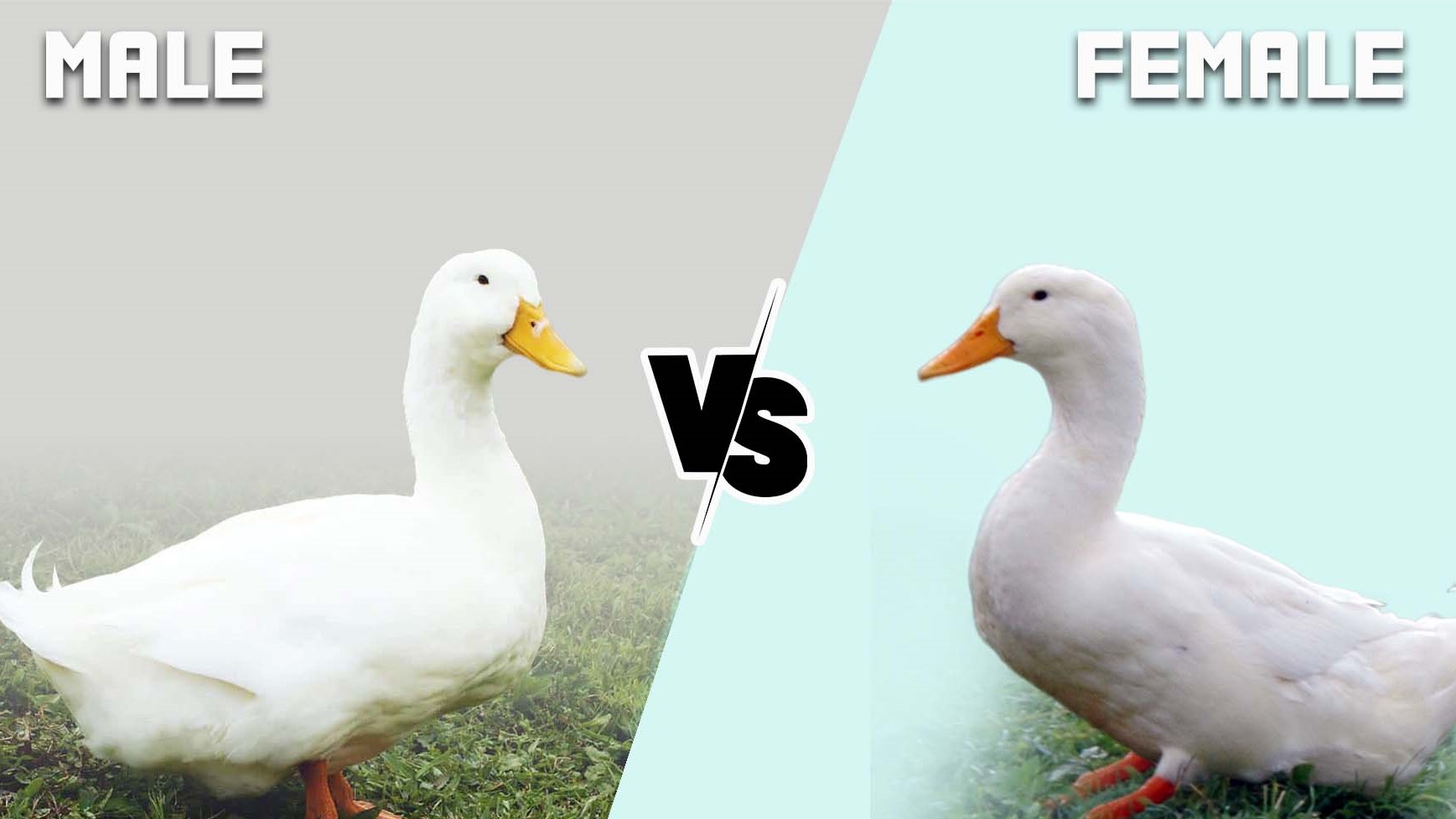Home>Pets & Animals>The Ultimate Guide: Unveiling The Secrets Of Distinguishing Male And Female Pekin Ducks!


Pets & Animals
The Ultimate Guide: Unveiling The Secrets Of Distinguishing Male And Female Pekin Ducks!
Published: January 29, 2024
Discover the secrets of distinguishing male and female Pekin ducks with our ultimate guide. Learn everything you need to know about these fascinating pets and animals!
(Many of the links in this article redirect to a specific reviewed product. Your purchase of these products through affiliate links helps to generate commission for Noodls.com, at no extra cost. Learn more)
Table of Contents
Introduction
Pekin ducks, with their distinct white plumage and charming waddle, are a popular choice among duck enthusiasts and farmers. These delightful waterfowl are not only cherished for their endearing appearance but also for their egg production and succulent meat. Understanding the differences between male and female Pekin ducks is essential for breeders and enthusiasts alike. By delving into their physical, behavioral, and reproductive characteristics, we can unravel the secrets that set these two genders apart.
In this comprehensive guide, we will embark on a fascinating journey to uncover the distinguishing features of male and female Pekin ducks. From their physical attributes to their unique behaviors, we will explore the intricacies that define each gender. By shedding light on their reproductive traits and providing practical tips for identification, we aim to equip you with the knowledge needed to discern between these charming waterfowl. So, let's embark on this enlightening expedition and unveil the secrets of distinguishing male and female Pekin ducks!
Read more: How To Tell If A Turtle Is Male Or Female
Physical Characteristics of Male and Female Pekin Ducks
When it comes to distinguishing between male and female Pekin ducks, their physical characteristics play a pivotal role. Understanding these traits is essential for anyone looking to identify the gender of these delightful waterfowl.
Male Pekin Ducks
Male Pekin ducks, also known as drakes, exhibit several distinctive physical features. One of the most prominent characteristics is their size. Drakes are generally larger and heavier than their female counterparts. Their bodies are robust, with a more elongated and pronounced shape. The most striking feature of male Pekin ducks is their curled tail feathers, which set them apart from the females. These feathers, known as drake feathers, have a distinctive curl that adds to the majestic appearance of the male Pekin duck.
Another notable physical trait of male Pekin ducks is their bill color. In comparison to female Pekin ducks, drakes boast a brighter and more vibrant bill. This feature serves as a visual indicator of their gender, especially when observed up close.
Female Pekin Ducks
Female Pekin ducks, also referred to as hens, possess their own set of distinguishing physical characteristics. One of the key features that differentiate female Pekin ducks from males is their size. Hens are relatively smaller and more petite in comparison to drakes. Their bodies are sleeker and more compact, reflecting a graceful and elegant demeanor.
In terms of plumage, female Pekin ducks exhibit a more subdued coloration, particularly on their feathers. While both genders share the iconic white plumage, hens tend to have softer and less pronounced feathering, contributing to a more refined appearance.
Additionally, the bill color of female Pekin ducks differs from that of males. Hens typically have a slightly duller bill color compared to drakes, adding another dimension to the visual contrast between the two genders.
Understanding these physical characteristics is instrumental in accurately identifying the gender of Pekin ducks. By recognizing these subtle yet distinct traits, enthusiasts and breeders can gain valuable insights into the captivating world of these charming waterfowl.
Behavioral Differences between Male and Female Pekin Ducks
Understanding the behavioral disparities between male and female Pekin ducks provides a fascinating glimpse into the dynamics of these captivating waterfowl. While both genders share common behavioral traits, there are subtle nuances that distinguish their interactions and social dynamics.
Male Pekin Ducks
Male Pekin ducks, or drakes, are known for their assertive and protective demeanor. They often exhibit a more vocal and boisterous nature, especially during the breeding season. Drakes engage in impressive displays of courtship behavior, including head bobbing, tail wagging, and vocalizing to attract the attention of female ducks. Their assertiveness and vocalization serve as a means of asserting dominance and signaling their readiness to mate.
In addition to their courtship rituals, male Pekin ducks display protective instincts, particularly when it comes to safeguarding their mate and offspring. They are vigilant and assertive in defending their territory and warding off potential threats, showcasing a strong sense of responsibility towards their flock.
Female Pekin Ducks
Female Pekin ducks, or hens, exhibit a more reserved and nurturing demeanor. They are attentive mothers, displaying remarkable dedication to caring for their eggs and ducklings. Hens are known for their gentle and nurturing behavior, creating a harmonious environment within the flock. They often communicate with soft quacks and maintain a sense of calm and order amidst the group.
During the breeding season, female Pekin ducks play an active role in selecting a suitable mate. They observe the courtship displays of the male ducks and make discerning choices based on the displays of vigor and vitality. This active involvement in the mating process reflects the discerning nature of female Pekin ducks in choosing a compatible partner.
Social Interactions
In social settings, male and female Pekin ducks exhibit distinct yet complementary behaviors. While drakes may engage in occasional displays of dominance and assertiveness, hens contribute to the social fabric of the flock by fostering a sense of harmony and cohesion. The interplay of these behavioral dynamics creates a balanced and cohesive social structure within Pekin duck communities.
Understanding these behavioral differences provides valuable insights into the intricate social dynamics of Pekin ducks. By observing and appreciating the unique behaviors of both genders, enthusiasts and breeders can develop a deeper understanding of these remarkable waterfowl, fostering a greater appreciation for their captivating personalities and social interactions.
Reproductive Characteristics of Male and Female Pekin Ducks
Reproductive characteristics play a pivotal role in distinguishing between male and female Pekin ducks. Understanding the unique traits and behaviors associated with reproduction provides valuable insights into the fascinating world of these delightful waterfowl.
Male Pekin Ducks
Male Pekin ducks, also known as drakes, exhibit distinct reproductive characteristics that are essential for understanding their role in the breeding process. One of the most notable features of drakes is their courtship behavior during the mating season. They engage in elaborate displays to attract the attention of female ducks, showcasing their vitality and genetic fitness. These displays often involve head bobbing, tail wagging, and vocalization, serving as a means of signaling readiness to mate.
In addition to courtship displays, male Pekin ducks play a crucial role in the reproductive process through mating behavior. Drakes are known for their assertiveness and persistence in pursuing potential mates, displaying remarkable vigor and determination during the mating ritual. Once a pair bond is established, drakes exhibit protective instincts, ensuring the safety and well-being of their mate and the subsequent brood.
Female Pekin Ducks
Female Pekin ducks, also referred to as hens, display remarkable reproductive characteristics that define their role in the breeding cycle. One of the most significant traits of hens is their instinctual drive for nesting and egg laying. During the breeding season, hens exhibit a strong inclination towards creating suitable nesting sites, often displaying meticulous behaviors in preparing the nest for egg deposition.
Once the nesting site is established, female Pekin ducks demonstrate dedicated egg laying behavior, contributing to the continuation of their species. Hens are known for their nurturing instincts, diligently tending to their eggs and ensuring optimal conditions for incubation. Their attentive and nurturing demeanor plays a crucial role in the successful hatching and rearing of ducklings, fostering a supportive environment for the next generation of Pekin ducks.
Reproductive Dynamics
The reproductive characteristics of male and female Pekin ducks intertwine to form a cohesive and intricate reproductive dynamic within the flock. The courtship displays of drakes, coupled with the nesting and egg laying behaviors of hens, create a harmonious cycle that perpetuates the species. The interplay of these reproductive traits underscores the vital role that each gender plays in ensuring the continuation of Pekin duck populations.
Understanding the reproductive characteristics of male and female Pekin ducks provides a deeper appreciation for the complexities of their breeding behaviors. By recognizing the unique traits and roles associated with reproduction, enthusiasts and breeders can gain a profound insight into the captivating world of these remarkable waterfowl.
This detailed exploration of the reproductive characteristics of Pekin ducks unveils the intricate dynamics that define their breeding behaviors, enriching our understanding of these delightful waterfowl.
Tips for Identifying Male and Female Pekin Ducks
Identifying the gender of Pekin ducks requires keen observation and an understanding of their distinct physical and behavioral traits. Whether you're a seasoned breeder or an enthusiastic duck admirer, mastering the art of gender identification is essential. Here are valuable tips to help you discern between male and female Pekin ducks:
1. Size Discrepancies
Male Pekin ducks, or drakes, are noticeably larger and heavier than their female counterparts. Their robust and elongated bodies stand in contrast to the sleeker and more petite build of female Pekin ducks, also known as hens. By comparing the size and overall physique of the ducks, you can begin to differentiate between the genders.
2. Distinctive Plumage
While both male and female Pekin ducks boast the iconic white plumage, subtle differences in feathering can aid in gender identification. Male ducks often exhibit more pronounced and majestic curled tail feathers, known as drake feathers, which set them apart from the females. In contrast, female ducks possess softer and less pronounced feathering, contributing to a more refined appearance.
3. Bill Color Variation
Another visual cue for identifying male and female Pekin ducks is the coloration of their bills. Male ducks typically showcase a brighter and more vibrant bill, serving as a visual indicator of their gender. In comparison, female ducks often have a slightly duller bill color, adding to the visual contrast between the two genders.
4. Vocalization and Behavior
Observing the vocalization and behavior of Pekin ducks can provide valuable insights into their gender. Male ducks are known for their assertive and vocal nature, especially during the breeding season, while female ducks exhibit a more reserved and nurturing demeanor. By paying attention to their interactions and vocalizations, you can gain further clues to distinguish between the genders.
Read more: The Ultimate Guide To Capricorn Female Flirting: Unleash Her Secret Seduction Techniques!
5. Courtship Displays
During the mating season, male Pekin ducks engage in elaborate courtship displays to attract female ducks. These displays often involve head bobbing, tail wagging, and vocalization. Observing these courtship behaviors can offer a clear indication of the males within the flock.
6. Nesting Behavior
Female Pekin ducks display dedicated nesting behavior, often exhibiting meticulous behaviors in preparing the nest for egg deposition. By observing their nesting activities and egg-laying behaviors, you can discern the presence of female ducks within the flock.
Mastering the art of identifying male and female Pekin ducks is a rewarding endeavor that deepens your connection with these delightful waterfowl. By honing your observational skills and leveraging these valuable tips, you can confidently discern between the genders, enriching your understanding of these charming and captivating creatures.
Conclusion
In conclusion, the journey to unravel the secrets of distinguishing male and female Pekin ducks has provided us with profound insights into the captivating world of these delightful waterfowl. From their physical characteristics to their behavioral nuances and reproductive dynamics, the distinctive traits of each gender have been illuminated, enriching our understanding of these charming creatures.
By delving into the physical attributes of male and female Pekin ducks, we have uncovered the subtle yet significant differences that define their appearances. The majestic curled tail feathers of male ducks, contrasted with the refined plumage of female ducks, serve as visual markers that distinguish between the genders. Additionally, the size and bill color variations further contribute to the visual contrast, providing valuable cues for identification.
Understanding the behavioral disparities between male and female Pekin ducks has offered a glimpse into their social dynamics and interactions. The assertive and protective nature of male ducks, coupled with the nurturing and discerning demeanor of female ducks, creates a harmonious balance within the flock. These behavioral nuances enrich the tapestry of their social structure, fostering a deeper appreciation for their captivating personalities.
Exploring the reproductive characteristics of male and female Pekin ducks has shed light on the vital roles they play in perpetuating their species. The courtship displays of drakes, intertwined with the nesting and egg-laying behaviors of hens, form a cohesive reproductive cycle that ensures the continuation of Pekin duck populations. This intricate interplay underscores the profound significance of each gender in sustaining their species.
In mastering the art of identifying male and female Pekin ducks, we have gained valuable tips and insights that empower us to discern between the genders with confidence. By honing our observational skills and leveraging these practical guidelines, we can navigate the enchanting world of Pekin ducks with clarity and understanding, deepening our connection with these remarkable waterfowl.
As we conclude this enlightening expedition, we carry with us a profound appreciation for the unique traits and behaviors that define male and female Pekin ducks. Their endearing charm, coupled with the intricacies of their gender distinctions, continues to inspire awe and fascination, enriching our journey into the captivating realm of avian diversity.











